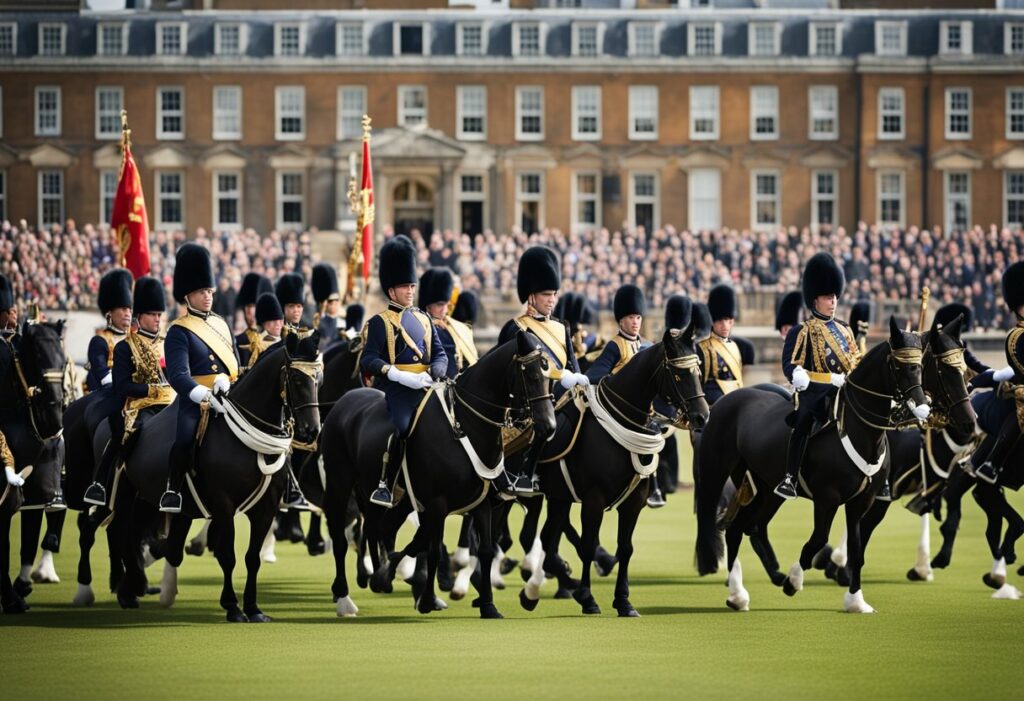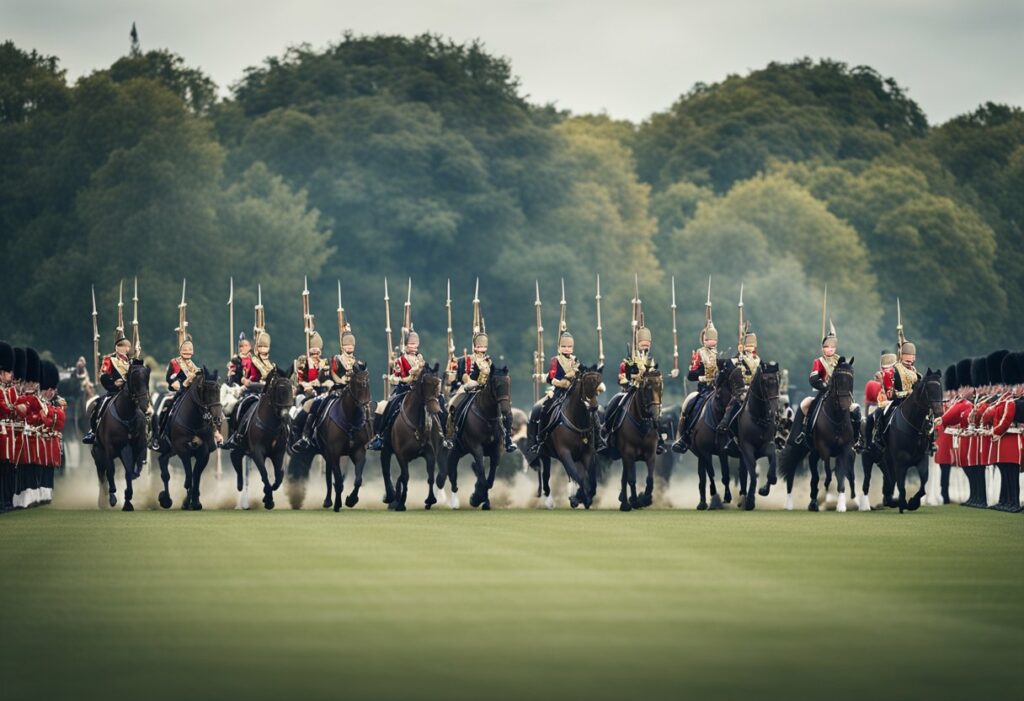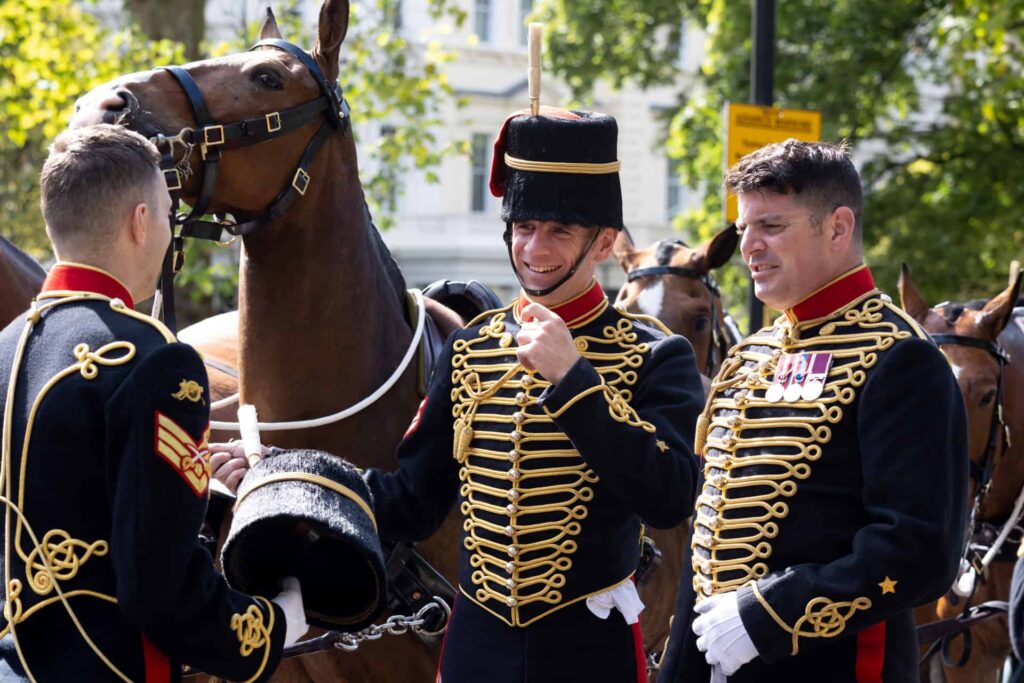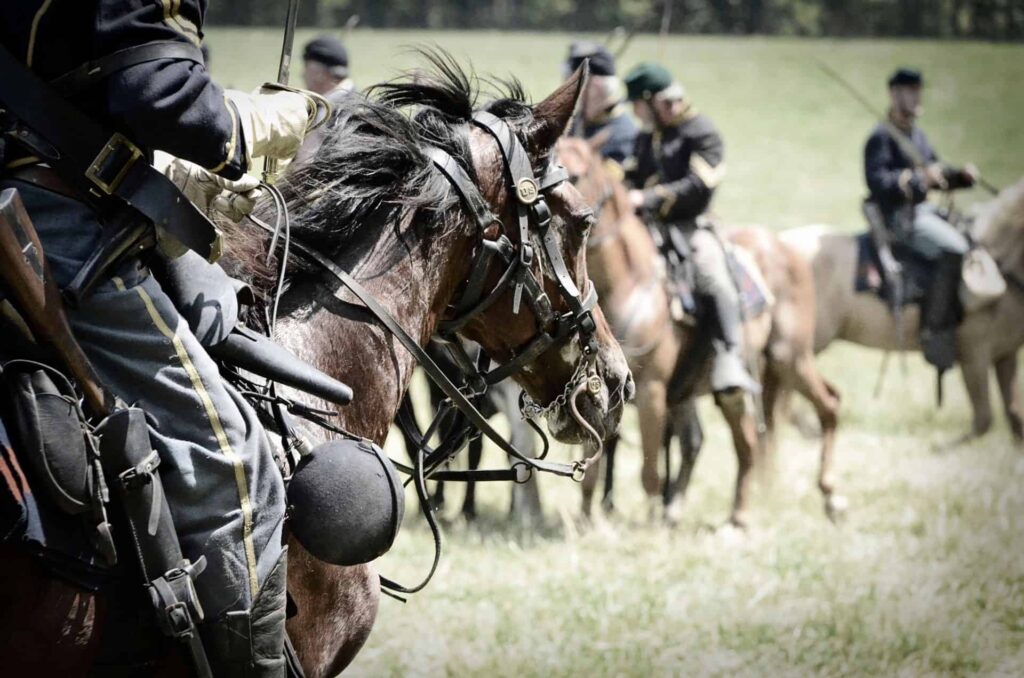The King’s Troop Royal Horse Artillery is a ceremonial unit of the British Army that represents the pinnacle of precision and tradition in military pageantry. Stationed at Woolwich, the unit is famed for its role in state ceremonies and royal events. The members of this elite troop are not only highly disciplined soldiers but also expert horse handlers, tasked with the care and management of the King’s Troop’s magnificent horses.
With a lineage tracing back to the early 19th century, the troop upholds an enduring heritage. Each soldier is equipped with the skills to drive a team of six horses that pull the historic First World War-era QF 13-pounder field guns. These guns, a significant component of Britain’s military heritage, are fired ceremonially at major national events, such as the Queen’s Birthday Parade and state visits. The King’s Troop Royal Horse Artillery is not just a testament to British martial tradition but also serves as a symbol of national pride and the continuing relationship between the monarchy and the military.
Key Takeaways
- The King’s Troop is a ceremonial unit located in Woolwich that embodies British tradition and pageantry.
- They skillfully manage both ceremonial duties and the maintenance of historic military equipment.
- The unit actively contributes to state events and royal ceremonies, showcasing the UK’s military heritage.
Origins and History
The King’s Troop Royal Horse Artillery holds a distinguished position within the British Army, with a heritage dating back to the origins of the Royal Horse Artillery in the 18th century. Its evolution reflects the breadth of British military history and its intersection with royal traditions.
Formation and Early Years
The roots of the Royal Horse Artillery trace back to 1793, during the French Revolutionary Wars, when the need arose for a mobile unit to support fast-moving cavalry. This unit was essential for providing fire support in the dynamic battlefield conditions of the era.
Evolution and World Wars
During the First World War (WWI), the Royal Horse Artillery played a crucial role, which continued into the Second World War (WWII). The wars catalyzed changes in military technology and tactics, yet the Horse Artillery maintained its significance within the Army structure.
Post-War Era to Modern Day
After WWII, in 1947, King George VI renamed the Riding Troop to The King’s Troop as a mark of honor. Since then, the King’s Troop has become synonymous with state occasions and ceremonial duties. It remains an active ceremonial unit of the British Army with its high standards and discipline, recognized as His Majesty’s Mounted Ceremonial Battery.
Royal and State Occasions
The King’s Troop is perhaps best known for its role in state occasions, such as firing salutes for royal birthdays and anniversaries and significant ceremonial events. The troop notably carried the coffin of King George VI in 1952 and later that of Diana, Princess of Wales, in 1997.
Locations and Movements
Historically based at St. John’s Wood Barracks, the King’s Troop moved to the purpose-built King George VI Lines at Woolwich in 2012. The move ensured the troop could continue its ceremonial duties effectively from a more modern base.
Interaction with Royalty
The King’s Troop has a storied association with British royalty, carrying out the prestigious Trooping the Colour annually in honor of Queen Elizabeth II and partaking in numerous royal reviews. These interactions affirm their essential role in the ceremonial life of the nation, serving both His and Her Majesty with a connection that has bridged generations.
Through their illustrious service, the King’s Troop has not only upheld a proud tradition, but continues to embody the history and prestige of The British Army in the modern era.
Roles and Responsibilities
The King’s Troop Royal Horse Artillery serves as a testament to the Royal Regiment of Artillery’s historical and ceremonial significance within the British Army. This prestigious unit performs a dual role, engaging both in State ceremonial responsibilities and in the operational training and duties that underline the combat capabilities of today’s modern artillery units.
Ceremonial Duties
The King’s Troop is primarily recognized for its ceremonial duties as part of the Household Division. They participate in prestigious events such as the Royal Windsor Horse Show and the Royal Tournament. The unit is adept at the Musical Drive, an exercise that showcases intricate maneuvers with horses and guns.
Salutes and Honours
Responsibilities include firing gun salutes for royal occasions such as birthdays and state funerals. They operate the historically significant 13-pounder guns, which serve as a symbol of national celebration or mourning during key events.
Training and Maneuvers
Soldiers within the troop undergo rigorous training to become proficient as mounted gunners and gun team drivers. This ensures precision in their ceremonial role and maintains their readiness for deployed artillery support, linking them with airborne and mounted units within the Royal Artillery.
Public Engagements
The King’s Troop engages with the public through demonstrations at events, contributing to the community and raising awareness of the British Army’s heritage and current roles. Their public presence also involves educational outreach, often coordinated with institutions like the National Army Museum.
Structure and Command
The Troop is structured to reflect traditional royal artillery batteries, with a commanding officer at the helm. It is part of the 1st Regiment Royal Horse Artillery, though retains a unique identity within the Royal Regiment of Artillery.
Alliances and Affiliations
They maintain historical alliances with civil and military entities such as the Honourable Artillery Company. These relationships foster a sense of unity and shared military history with other cavalry and ordnance organizations.
Military Ranks and Orders
The unit is composed of both officers and soldiers, with rank structures similar to those found in other Royal Artillery units. This hierarchy is crucial for maintaining discipline and order during complex ceremonial tasks and military operations.
Comparable Cavalry Units
As a mounted ceremonial battery, the King’s Troop shares traits with other respected cavalry units across the globe, blending traditions of horsemanship with military function. Their presence at ceremonial events often parallels the roles performed by comparable units in allied nations’ armed forces.

Military Equipment and Regalia
The King’s Troop Royal Horse Artillery boasts a unique mix of historical weaponry and regalia that encapsulate tradition and precision. Each piece of equipment plays a critical role in the Troop’s ceremonial and practical functions, maintaining a link to its storied past while serving its modern-day ceremonial duties.
Historical Artillery
The artillery pieces central to The King’s Troop are the 13-pounder guns. These historic World War-era QF 13-pounder guns serve not only as ceremonial items but also as symbols of the Troop’s legacy. Each field artillery piece is drawn by a team of six horses and manned by soldiers trained in the roles of gunner and gun team driver.
Mounted Unit and Horsemanship
The King’s Troop is a mounted unit where each soldier learns to care for and command a team of horses. These horses, including majestic black horses, also referred to as chargers, are integral to both mobile fire support and the ceremonial aspects of the Troop’s duties.
Ceremonial Garments and Tools
Every member of The King’s Troop is outfitted in traditional ceremonial garments that include items made by in-house tailors and saddlers. The uniforms and tools reflect the heritage and precision of their roles during state occasions when they execute firing salutes.
Riding and Artillery Transport
The transport of artillery requires highly skilled riding, where each gun team driver plays a vital role. The gun carriages are expertly maneuvered by the horses, requiring both the animals and their drivers to maintain a high level of fitness and training for seamless execution during events.
Maintenance and Logistics
Behind the scenes, a team dedicated to maintenance and logistics ensures that all equipment is parade-ready. Roles such as the saddler, tailor, and farrier are crucial to the day-to-day upkeep of the Troop’s equipment and the welfare of the horses, allowing The King’s Troop Royal Horse Artillery to represent the British Army with distinction.
Traditions and Rituals
The King’s Troop Royal Horse Artillery is steeped in traditions that showcase the grandeur of military heritage and the precision of ceremonial roles. These rituals reflect the unit’s cultural and historical significance, and their performances are a key component of Britain’s state and royal ceremonies.
Trooping the Colour and Parades
The King’s Troop plays a pivotal role in Trooping the Colour, an annual event marking the Queen’s official birthday. They, along with the Household Division, provide a grand display of pomp and pageantry. In parades, they exhibit the order of precedence, following an age-old hierarchy that is observed with great respect and precision during these grand events.
Royal Windsor and Commemorations
At the Royal Windsor Horse Show, the King’s Troop demonstrates their equestrian prowess and Ride and Drive abilities. This prestigious event, coupled with memorial services such as those in Green Park and West Sussex, witnesses the King’s Troop performing commemorative duties and firing salutes to honor past and present sacrifices.
Musical Performances and Competitions
Their Musical Drive—a complex, choreographed display of horsemanship and artillery skill—accentuates the King’s Troop’s mastery in equestrian disciplines. This ceremonial maneuver involves teams of six horses flawlessly pulling World War I-era guns, showcasing not just tradition but also competitive spirit during military tattoos and public festivals.
Cultural and Historical Significance
The King’s Troop holds a unique place in Britain’s cultural tapestry, representing the living history of the nation’s military and royal traditions. Originating from Goodwood in West Sussex, this esteemed unit transcends mere ceremonial duty, embodying the cultural legacy and the ongoing story of the British Army’s role in state and society.
Engagement and Education
The King’s Troop Royal Horse Artillery is an exemplar of public engagement and education, offering a unique insight into military heritage and horsemanship through ceremonial duties and outreach programs.
Community Participation
The King’s Troop plays a vital role in the community, participating in events such as the Royal Tournament and local parades, which strengthens civil-military relationships. They demonstrate the pride and discipline of military service, bringing historical traditions to the forefront of public consciousness.
Outreach and Displays
During state occasions, such as the annual Goodwood Festival, the Troop performs the iconic Musical Ride, showcasing their precision and skill. Gun salutes in London’s royal parks are a testament to their role in ceremonial duties, often drawing significant crowds and media coverage.
Training Programs
The Troop provides comprehensive training programs for its riders and troopers, focused on horsemanship and the operation of ceremonial guns. These programs emphasize the historical importance and order of precedence within their ranks, ensuring the unit operates with impeccable standards.
Media and Coverage
Media engagement is critical for the Troop, with coverage of their ceremonial roles providing education on the armed forces and British history. Regular appearances at the National Army Museum and featured segments on various platforms allow the unit to maintain its esteemed reputation and captivate a wider audience.

Global Presence and Relations
The King’s Troop, Royal Horse Artillery holds a distinctive global presence through its ceremonial duties and contributes to the United Kingdom’s military relations on an international stage, fostering ties with various military traditions and units across the globe.
International Alliances
The King’s Troop nurtures alliances beyond the UK, participating in commemorations and ceremonies in alliance with countries such as the Netherlands and Canada. These alliances demonstrate a commitment to international relations and the maintenance of historical ties between nations.
Participation in Worldwide Events
Esteemed for their ceremonial excellence, the Troop often engages in international events, such as state funerals and royal celebrations. For instance, they played a significant role in the funeral ceremony of Diana, Princess of Wales, which was broadcast globally, showcasing the UK’s rich military tradition to the world.
Comparative Analysis with Other Units
The King’s Troop shares several similarities with the Household Cavalry Mounted Regiment, as both serve to fulfill ceremonial roles within the British Army. However, the Troop is unique in its use of historic ordnance for salutes and royal ceremonies, which contrasts with the more combat-focused roles of conventional Royal Artillery battalions.
Impact on Global Military Traditions
The King’s Troop, Royal Horse Artillery, influences global military traditions through its continued use of the Mounted Ceremonial Battery, a practice that harkens back to the historical role of horse artillery. This steadfast adherence to tradition leaves a lasting impact on military pageantry worldwide, including the ceremonial practices at the Palace of Westminster.
Frequently Asked Questions
Here are some of the most common inquiries about the roles, horses, and traditions of the King’s Troop Royal Horse Artillery.
What roles are available within the King’s Troop Royal Horse Artillery?
Within the King’s Troop Royal Horse Artillery, soldiers are trained for a variety of roles—including horsemanship, driving the six-horse teams, gunnery, and ceremonial duties. Each soldier learns to care for the horses and maintain the equipment necessary for their ceremonial responsibilities.
What types of horses are used by the King’s Troop Royal Horse Artillery?
The King’s Troop Royal Horse Artillery uses a selection of horses that are both strong and disciplined, with the majority being black or bay in color to maintain a uniform appearance during ceremonial duties. Teams of six horses draw each of the First World War-era QF 13-pounder guns used in parades and state events.
What breed of horses did the Royal Horse Artillery use historically?
Historically, the breeds used by the Royal Horse Artillery would have been chosen for their strength and endurance, with a preference for robust breeds capable of handling the demands of maneuvering heavy field guns.
How can one access the World War I service records of the Royal Horse Artillery?
To access the World War I service records of the Royal Horse Artillery, one should consult the National Archives. These records provide historical details regarding the service of individual soldiers and units during the conflict.
What did the uniform of the Royal Horse Artillery look like during World War I?
During World War I, the uniform of the Royal Horse Artillery was practical and designed for service in the field. It typically consisted of a service dress tunic, breeches, and a peaked cap or steel helmet, depending on the circumstances.
Where can one find the King’s Troop Royal Horse Artillery museum?
The King’s Troop Royal Horse Artillery museum is located within the unit’s barracks in Woolwich, London. The museum showcases the troop’s history, uniforms, and the role it plays in state ceremonial duties.
Sources
- https://en.wikipedia.org/wiki/King%27s_Troop,_Royal_Horse_Artillery
- https://www.army.mod.uk/who-we-are/corps-regiments-and-units/royal-artillery/the-kings-troop-royal-horse-artillery/
- https://www.horseandhound.co.uk/features/the-kings-troop-royal-horse-artillery-823614
Last Updated on December 9, 2023 by Nate Dewsbury



